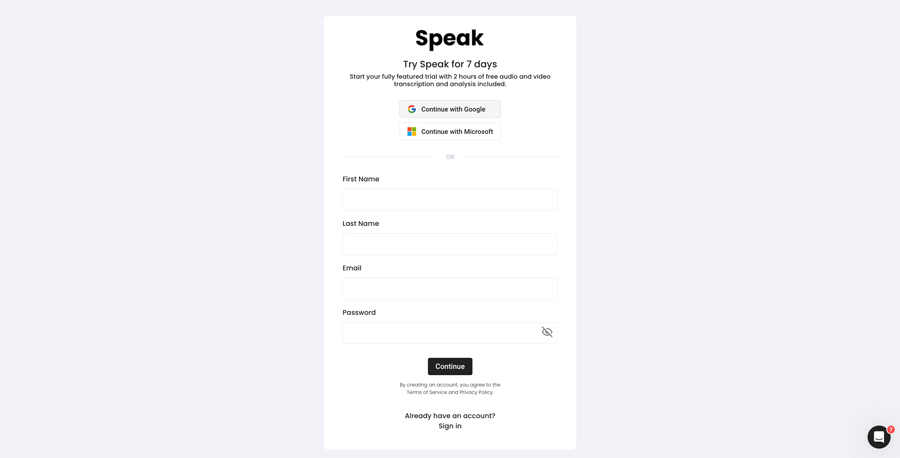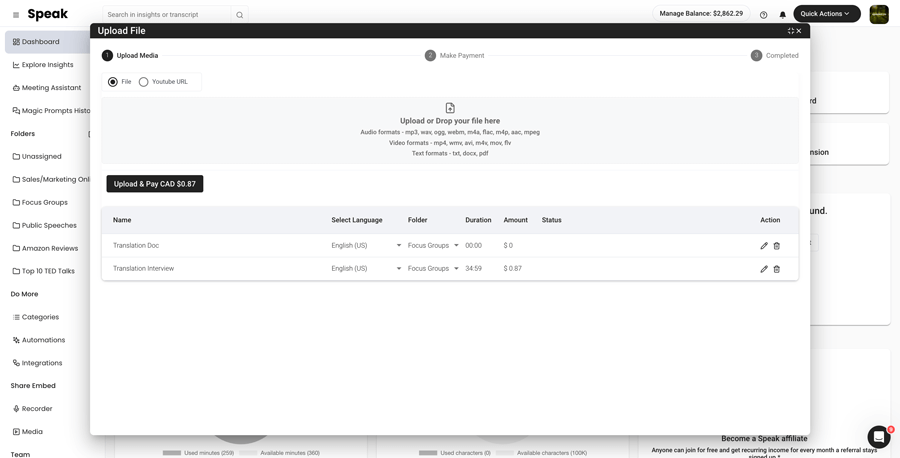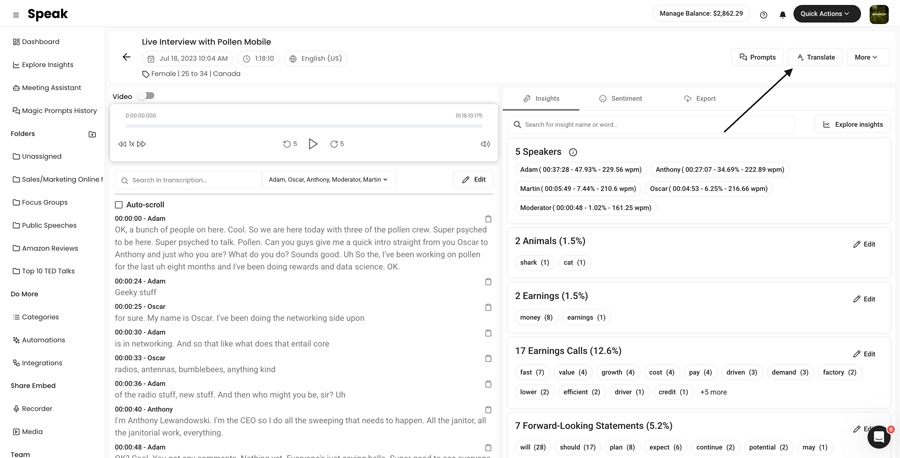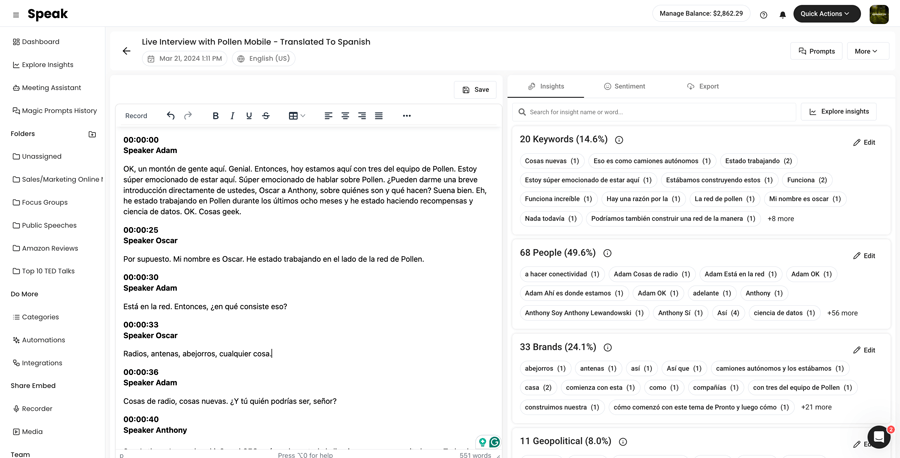How To Translate Chinese (Simplified) to Hebrew
Translating Chinese (Simplified) to Hebrew is super simple!

Step 1: Register for Speak
Register for Speak using this link.
Once you register, you can instantly begin translating your Chinese (Simplified) to Hebrew file(s).

Step 2: Upload Your Chinese (Simplified) file(s)
As soon as you log in, you will be redirected to the dashboard.
Once there, you can select the Quick Action “New Upload”.
In Speak, you can seamlessly upload, transcribe and translate audio, video and text files all at once!

Step 3: Translate Your Chinese (Simplified) file(s) to Hebrew
Once the file is uploaded, simply visit your file and select “Translate”.
If it is an audio and video file, Speak will ask you if you want to keep the speaker names and timestamps in the translation.
Want to translate many files at once? No problem!
You can view the files you want to automatically translate from Chinese (Simplified) to Hebrew from the folder level and instantly translate as many files as you need with our artificial intelligence translation in just a few clicks.

Step 4: That’s It! View, Analyze, Modify & Export Your New Hebrew file(s)
Once the translation is done, you will be alerted and you will see a new document in the same folder your original file is in.
The file will be named the same but with a dash indicating that it is the translated version.
Need support with your Chinese (Simplified) translation?
We are always here and happy to help at Speak!
Just send us a message on live chat on the bottom right corner and we will ensure you are set up for success.
Interested in translating Chinese (Simplified) or other languages to different languages? View our entire list of supported translation languages here.
Automatic, accurate, instant AI translation from Chinese (Simplified) to Hebrew is here for you.
Register for Speak using this link and begin translating Chinese (Simplified) to Hebrew today.
Unlocking Global Communication: The Power of Translating Chinese (Simplified) to Hebrew
In today’s global village, the ability to communicate across languages is more vital than ever. For businesses, researchers, and individuals navigating the complexities of international markets and cultural landscapes, leveraging advanced technology to bridge language barriers is a game-changer. This article delves into the significant value and numerous advantages of utilizing AI-powered tools for translating Chinese (Simplified) to Hebrew, highlighting the transformative impact this can have across various sectors.
Amplifying Reach and Engagement: Benefits for Businesses and Researchers
Unlocking the potential of automatic translation from Chinese (Simplified) to Hebrew opens a treasure trove of opportunities for businesses and researchers. Key benefits include:
- Global Market Expansion: Businesses can tap into new markets, reaching audiences previously beyond their linguistic reach. This fosters global growth and diversification.
- Cultural Sensitivity and Accuracy: Precision in translation ensures that cultural nuances are preserved, enhancing brand image and credibility in foreign markets.
- Efficiency and Cost-effectiveness: AI-powered translation drastically reduces the time and expense involved in traditional translation processes, empowering users to allocate resources more effectively.
- Enhanced Research Capabilities: Researchers benefit from swift access to a broader range of sources and collaborators, fostering cross-cultural studies and innovation.
Integrating Technology for Seamless Translations
At the forefront of this linguistic revolution is Speak Ai, harnessing the power of NLP, large language models, and Generative AI to offer a comprehensive translation solution. From automatically transcribing and analyzing audio and video in multiple languages to delivering accurate text translations, Speak Ai’s advanced technology provides seamless Chinese (Simplified) to Hebrew translation.
How Speak Ai’s Technology Empowers Users
Speak Ai stands out by providing a holistic solution that addresses the nuances and complexities of language translation:
- AI Meeting Assistant: Automatic transcription and analysis of meetings in languages including Chinese and Hebrew, compatible with Microsoft Teams, Zoom, Google Meet, and Webex.
- Real-time Translation: Instantly translate audio, video, and text, enabling effective communication and understanding across languages.
- Data Visualization: Transform language data into actionable insights, highlighting trends and patterns in cross-language interactions.
The Crucial Role of AI Translation in Today’s World
With the globalization of businesses and the increasing importance of cultural and linguistic diversity, the demand for efficient and accurate translation services has skyrocketed. AI translation, especially from Chinese (Simplified) to Hebrew, plays a pivotal role in bridging communication gaps, fostering international collaboration, and driving innovation.
Applications and Case Studies
From multinational corporations streamlining operations across countries to academic institutions facilitating groundbreaking research, the applications of AI translation are vast. Speak Ai’s platform has been instrumental in various sectors, catering to the unique needs of our diverse clientele with a 4.9 rating on G2 and a user base of over 150K.
Revolutionizing Communication: A Case Study
One exemplary case highlighted the transformative impact of Speak Ai’s translation technology in a multinational campaign, where marketing content was efficiently translated from Chinese to Hebrew, significantly increasing engagement rates in the target demographic.
The Linguistic Landscape: Chinese (Simplified) and Hebrew
Before delving deeper into the mechanics and benefits of translation, understanding the intricacies of both the Chinese (Simplified) and Hebrew languages provides valuable insights into the challenges and opportunities inherent in their translation.
Geographical Prevalence and Historical Significance
Chinese (Simplified) is predominantly used in China, Singapore, and Malaysia, serving as the primary language for over a billion people. Its evolution has been marked by efforts to make literacy more accessible, illustrating the language’s dynamic nature. Hebrew, primarily spoken in Israel, boasts about 9 million speakers. It stands as a testament to linguistic revival, transitioning from an ancient liturgical language to a vibrant, modern tongue.
Diverse Linguistic Features
Despite their distinct origins, Chinese (Simplified) and Hebrew share fascinating features, such as the importance of context in meaning. However, their differences, including writing systems and syntax, present unique challenges in translation, underscoring the importance of sophisticated AI tools capable of navigating these complexities.
Embracing Technology for Effective Translations
In conclusion, the journey from Chinese (Simplified) to Hebrew is not just about converting words but about bridging worlds. Through technological prowess, such as that offered by Speak Ai, businesses, and researchers can transcend linguistic boundaries, unlocking new realms of possibilities. As we continue to embrace these advances, the future of global communication looks more interconnected than ever.
Experience the power of seamless translation and unlock your global potential with Speak Ai. Join our growing community of over 150K users and elevate your linguistic capabilities today.
Discover More with Speak Ai
For more information on our AI-powered translation and transcription solutions, visit [Speak Ai](https://speakai.co) and revolutionize the way you communicate and analyze language data across borders.
FAQs
What locations are Chinese (Simplified) and Hebrew popular?
Chinese (Simplified) is widely spoken in China, Singapore, and Malaysia, with over a billion native speakers. Hebrew, while mainly spoken in Israel, has around 9 million speakers and is known for its historical and cultural significance in Jewish communities globally.
What are some fun facts about Chinese (Simplified) and Hebrew?
Chinese (Simplified) was developed to make the written language more accessible and promote literacy, while Hebrew is a unique example of a language that was revived from ancient use to become the everyday language of an entire country.
What are the differences and similarities between Chinese (Simplified) and Hebrew?
While both languages emphasize the importance of context, they differ significantly in their writing systems—Chinese uses a logographic system, while Hebrew is alphabetic. These differences pose challenges in translation, highlighting the need for advanced AI solutions like Speak Ai.
Translate Chinese (Simplified) To These Other Supported Languages:
- Translate Chinese (Simplified)-to-Albanian
- Translate Chinese (Simplified)-to-Amharic
- Translate Chinese (Simplified)-to-Arabic (Egypt)
- Translate Chinese (Simplified)-to-Arabic (Iraq)
- Translate Chinese (Simplified)-to-Arabic (Israel)
- Translate Chinese (Simplified)-to-Arabic (Jordan)
- Translate Chinese (Simplified)-to-Arabic (Kuwait)
- Translate Chinese (Simplified)-to-Arabic (Lebanon)
- Translate Chinese (Simplified)-to-Arabic (Oman)
- Translate Chinese (Simplified)-to-Arabic (Palestinian Authority)
- Translate Chinese (Simplified)-to-Arabic (Qatar)
- Translate Chinese (Simplified)-to-Arabic (Saudi Arabia)
- Translate Chinese (Simplified)-to-Arabic (Syrian Arab Republic)
- Translate Chinese (Simplified)-to-Arabic (United Arab Emirates)
- Translate Chinese (Simplified)-to-Arabic Modern Standard (Bahrain)
- Translate Chinese (Simplified)-to-Armenian
- Translate Chinese (Simplified)-to-Azerbaijani
- Translate Chinese (Simplified)-to-Bengali
- Translate Chinese (Simplified)-to-Bosnian
- Translate Chinese (Simplified)-to-Bulgarian
- Translate Chinese (Simplified)-to-Catalan
- Translate Chinese (Simplified)-to-Chinese (Cantonese, Traditional)
- Translate Chinese (Simplified)-to-Chinese (Simplified)
- Translate Chinese (Simplified)-to-Chinese (Traditional)
- Translate Chinese (Simplified)-to-Croatian
- Translate Chinese (Simplified)-to-Czech
- Translate Chinese (Simplified)-to-Danish
- Translate Chinese (Simplified)-to-Dari
- Translate Chinese (Simplified)-to-Dutch
- Translate Chinese (Simplified)-to-English
- Translate Chinese (Simplified)-to-English (Australia)
- Translate Chinese (Simplified)-to-English (India)
- Translate Chinese (Simplified)-to-English (Ireland)
- Translate Chinese (Simplified)-to-English (New Zealand)
- Translate Chinese (Simplified)-to-English (Scottish)
- Translate Chinese (Simplified)-to-English (South African)
- Translate Chinese (Simplified)-to-English (United Kingdom)
- Translate Chinese (Simplified)-to-English (United States)
- Translate Chinese (Simplified)-to-Estonian
- Translate Chinese (Simplified)-to-Farsi (Persian)
- Translate Chinese (Simplified)-to-Finnish
- Translate Chinese (Simplified)-to-French
- Translate Chinese (Simplified)-to-French (Canada)
- Translate Chinese (Simplified)-to-Georgian
- Translate Chinese (Simplified)-to-German
- Translate Chinese (Simplified)-to-German (Swiss)
- Translate Chinese (Simplified)-to-Greek
- Translate Chinese (Simplified)-to-Gujarati
- Translate Chinese (Simplified)-to-Haitian Creole
- Translate Chinese (Simplified)-to-Hausa
- Translate Chinese (Simplified)-to-Hebrew
- Translate Chinese (Simplified)-to-Hindi
- Translate Chinese (Simplified)-to-Hungarian
- Translate Chinese (Simplified)-to-Icelandic
- Translate Chinese (Simplified)-to-Indonesian
- Translate Chinese (Simplified)-to-Irish
- Translate Chinese (Simplified)-to-Italian
- Translate Chinese (Simplified)-to-Japanese
- Translate Chinese (Simplified)-to-Kannada
- Translate Chinese (Simplified)-to-Kazakh
- Translate Chinese (Simplified)-to-Korean
- Translate Chinese (Simplified)-to-Latvian
- Translate Chinese (Simplified)-to-Lithuanian
- Translate Chinese (Simplified)-to-Macedonian
- Translate Chinese (Simplified)-to-Malay
- Translate Chinese (Simplified)-to-Malayalam
- Translate Chinese (Simplified)-to-Maltese
- Translate Chinese (Simplified)-to-Marathi
- Translate Chinese (Simplified)-to-Mongolian
- Translate Chinese (Simplified)-to-Norwegian
- Translate Chinese (Simplified)-to-Pashto
- Translate Chinese (Simplified)-to-Persian
- Translate Chinese (Simplified)-to-Polish
- Translate Chinese (Simplified)-to-Portuguese
- Translate Chinese (Simplified)-to-Portuguese (Brazilian)
- Translate Chinese (Simplified)-to-Portuguese (Portugal)
- Translate Chinese (Simplified)-to-Punjabi
- Translate Chinese (Simplified)-to-Romanian
- Translate Chinese (Simplified)-to-Russian
- Translate Chinese (Simplified)-to-Serbian
- Translate Chinese (Simplified)-to-Sinhala
- Translate Chinese (Simplified)-to-Slovak
- Translate Chinese (Simplified)-to-Slovenian
- Translate Chinese (Simplified)-to-Somali
- Translate Chinese (Simplified)-to-Spanish
- Translate Chinese (Simplified)-to-Spanish (Mexico)
- Translate Chinese (Simplified)-to-Swahili
- Translate Chinese (Simplified)-to-Swedish
- Translate Chinese (Simplified)-to-Tamil
- Translate Chinese (Simplified)-to-Telugu
- Translate Chinese (Simplified)-to-Thai
- Translate Chinese (Simplified)-to-Turkish
- Translate Chinese (Simplified)-to-Ukrainian
- Translate Chinese (Simplified)-to-Urdu
- Translate Chinese (Simplified)-to-Uzbek
- Translate Chinese (Simplified)-to-Vietnamese
- Translate Chinese (Simplified)-to-Welsh



